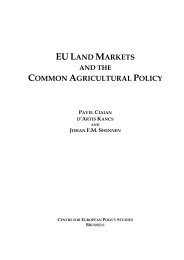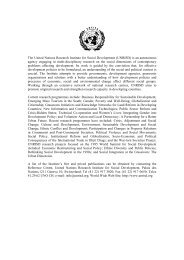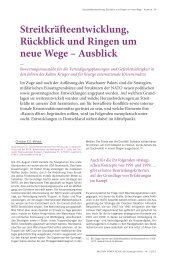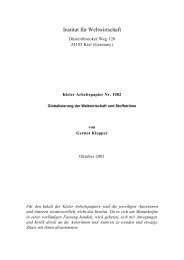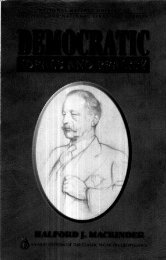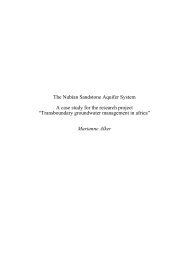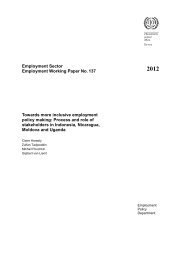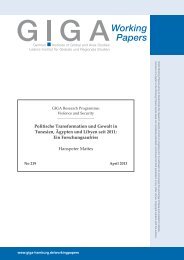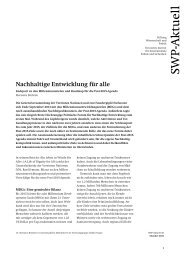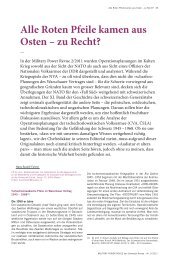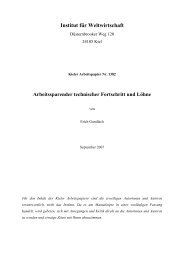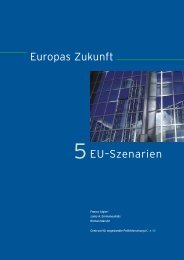Understanding and Measuring Creative Thinking in Leaders
Understanding and Measuring Creative Thinking in Leaders
Understanding and Measuring Creative Thinking in Leaders
Create successful ePaper yourself
Turn your PDF publications into a flip-book with our unique Google optimized e-Paper software.
194 THE 71F ADVANTAGEskewed (-.41 versus .11), but also considerably less leptokurtic (-.15versus .42), mean<strong>in</strong>g that the preponderance of MM openness scoresare far more positively lean<strong>in</strong>g than those for the IPIP–NEO, as well ashav<strong>in</strong>g a flatter or wider distribution. These results raise the questionwhether the two scales are measur<strong>in</strong>g the same phenomena with respectto our population, at least <strong>in</strong> terms of how they differentially distributeour subjects.It is <strong>in</strong>structive to compare our sample’s openness means on thetwo <strong>in</strong>struments to those from Sauciers’s (1994) MM sample of 1,125community residents of Eugene-Spr<strong>in</strong>gfield, Oregon, <strong>and</strong> Johnson’s(2006) IPIP–NEO sample of 20,993 Web users. For the m<strong>in</strong>i-markers,Saucier reports an openness scale mean of 6.6, or nearly the same asours (6.4). Johnson, however, f<strong>in</strong>ds an openness mean that is decidedlyhigher than ours (3.6 versus 3.1). This comparison alone, however, doesnot make clear whether the differences are due to the <strong>in</strong>struments themselves,or rather the variable nature of the sample populations.The descriptive statistics for the <strong>in</strong>dividual openness MM items<strong>and</strong> IPIP–NEO facets are shown <strong>in</strong> table 8–10. These statistics help clarifythe sources of variability on the respective measures. While thereare statistically significant mean differences among the MM items—forexample, between “<strong>in</strong>tellectual” <strong>and</strong> “philosophical” (t = 7.8, p < .05)—differences are more pronounced on the IPIP–NEO. To cite two examples,means on both O1–Imag<strong>in</strong>ation <strong>and</strong> especially O6–Liberalism arebelow the scale midpo<strong>in</strong>t (neutral) <strong>and</strong> are significantly lower than theO5–Intellect mean (t = 11.1, p < .05 <strong>and</strong> t = 21.0, p < .05, respectively).(Statistics for the <strong>in</strong>dividual IPIP–NEO items are found <strong>in</strong> appendix B.)Multivariate AnalysisA multivariate regression analysis was conducted to help answerthe critical question of how well the MM openness scale represents therelevant facets on the IPIP–NEO openness scale. St<strong>and</strong>ardized betas arepresented to show the relative predictive power of each IPIP–NEO facetvis-à-vis MM scale scores. The results are presented <strong>in</strong> table 8–11.The conclusion from the descriptive analyses that the IPIP–NEOopenness scale might well be measur<strong>in</strong>g at least somewhat differentphenomena than the MM openness scale is considerably re<strong>in</strong>forcedby these results. The MM openness scale scores are most clearly predictedby O5–Intellect with an extremely strong st<strong>and</strong>ardized beta orbeta weight of .62. There is only one other def<strong>in</strong>itely significant effect foran associated IPIP–NEO facet, O4–Adventurousness, though its relative



